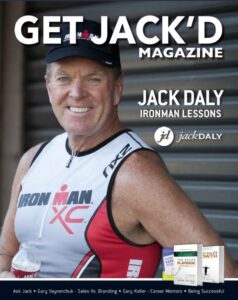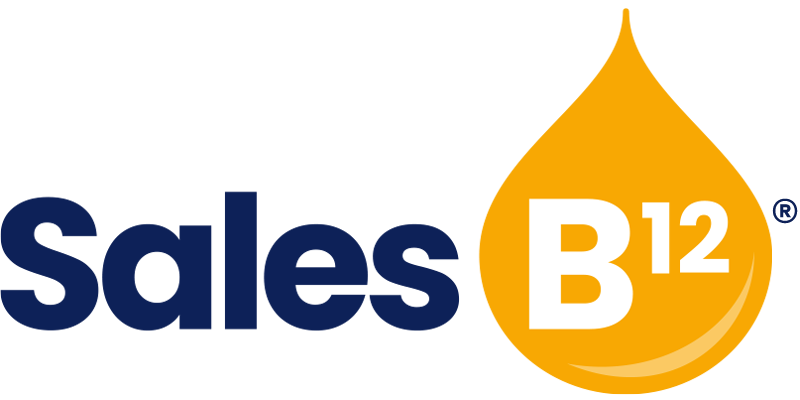In this Sales B12™ episode with Jack Daly and Caryn Kopp, they dive deep into real-life examples of how cultivating centers of influence is a total game changer for business and sales success. Jack shares an example of how his swim coach referred $1M in sales to one person in his network without even trying! And Caryn discusses how Jack’s center of influence “wheel” set the stage for years of business growth and expansion – all while adding more value to clients, reducing churn, and making lifelong friends!
(Caryn)
Tell us about the concept of a swim coach, Jack, and how that relates to sales success.
Example of the Swim Coach Center of Influence
(Jack Daly)
Let’s take the mask off of it and call it what most people are comfortable with, which is centers of influence. Sometimes your very best customer will never buy or use your service – but they could send you a lifetime of business!
I teach this concept with a story about me learning how to swim so that I could do the Ironman Triathlon (swim, bike, and run). And at 58 years old, I didn’t know how to swim. Most people wonder, how could that be? But most people, quite frankly, don’t know how to swim 2.4 miles in deep water in the ocean on the clock and be timed!
Steve, the swim coach, introduced me to the bike shop.
coach, introduced me to the bike shop.
I hired a swim coach. His name was Steve, and he was tremendous. He didn’t just teach me how to swim, though. Eventually, he introduced me to a bike shop owner who suited me up with the perfect bike, which is important because it’s a 112-mile-long bike race. I get this beautiful bike, and people say, “Gosh, 112 miles on a bike! What’s your ass feel like when you’re done?” The truth is you’re not in the saddle that much. It’s not the bike saddle but the overall bike fit that’s important. Steve introduced me to somebody called the Bike Butler, who took a hacksaw to portions of my brand new bike to fit it personally to me.
Then my swim coach introduced me to a nutritionist, strength coach, and more.
Steve also introduced me to a nutritionist because I needed to find a way to sustain myself. It takes me about 13 hours to do the Ironman, and they don’t feed you along the way: you have to figure that out yourself. And there are specific muscles that you use that need to be attended to, so Steve introduced me to my strength coach. I could go on because he had several other people in his network, but I’ll stop here.
Steve’s primary mission was to help his clients be better triathletes.
He put this network together, explaining, “I figured I would focus on triathletes as swim students when I came to California from Boston. I figured that if I could help my clients be better triathletes in any capacity and help them with any of their needs, they would stay with me longer.”
The outcome of putting clients first.
1) A powerful referral network: I started thinking, this is sales, not just swimming, right? And then Steve said, “The network becomes a referral source.” And it’s not just his professional network that becomes a referral source; his clients also become a referral network. I’m forever referring people to Hank, Steve, and the people doing all this stuff for me.
2) More sales all around. Here’s what I want to underscore about how this can be impactful. If you were to buy a good triathlon bike, it would probably cost $7,000. I asked Steve, “How many people are you sending over to Hank the bike shop every month?” He gave me a number, and I asked, “What percentage do you think are buying a bike from him?”
“Probably 50%,” he said.
I replied, “Steve, you’re wrong. It’s more than 50% because the people you’re sending over already trust your recommendation and are more likely to buy.” Selling is the transfer of trust.
We did the math, and it was like a lightning bolt for Steve. “Do you realize you sent more than a million dollars of bike sales to Hank in the last seven years?” I looked at him, and his face was in shock. Then I asked, “By the way, how many bikes have you bought from Hank?”
“None,” he replied.
A guy who never bought a bike from Hank because he already had three was responsible for $1 million in sales in seven years. Imagine trying to sell one bike at a time compared to nurturing a relationship with ten swim coaches. If I were a bike shop owner, all I would need to keep happy would be those ten centers of influence.
I challenge the listener with this question: Who are the swim coaches, the centers of influence, in your business?
How to Find and Cultivate Centers of Influence
(Caryn Kop)
How does the audience find centers of influence for themselves? And how do they nurture that relationship to create the situation you described?
(Jack Daly)
For a detailed answer, I have a free magazine, Get Jacked, on my website and one of the cover stories is Who is Your Swim Coach? The listener could go to my website and learn more about how to find their centers of influence.
To put it simply, you have to identify the criteria that will make an excellent referral partner in your business. It could be somebody already operating with you, and you could get ten more.
I built several businesses in the mortgage industry before I became a speaker. I told my sellers that instead of trying to get homeowner A and homeowner B one transaction at a time, build relationships with the realtors and builders. If you develop a relationship with ten stellar realtors that did a lot of business, you only need to keep those ten happy. They’ll send you their borrowers and home buyers on a regular, ongoing basis. Usually, a top realtor or a builder will generate 10 or 20 sales a month, and they’ll parse them out to two or three people.
I know successful sellers in the mortgage business, and that’s all they do. By the way, the realtor referring their clients to the mortgage lender never did a loan with them because they didn’t move, and they didn’t need a loan.
Let me flip this onto you. From your experience as a Door Opener®, what are your thoughts about centers of influence?
(Caryn Kopp)
Even though we are best known for the Door Opener Service®, I also have centers of influence for my business. How do you think I got started? It’s not always about the onesie twosies, although those are important, especially when strategically chosen. Just as you would select the prospects you want to go after, the same is true for your centers of influence.
Not every ‘swim coach’ will be a great referral partner for you. Who are the centers of influence that will lead you to the kind of business you want? Sometimes they serve the same clientele, and sometimes they have the information you need.
It’s crucial when you decide where you’re going to spend your time, from a business development standpoint, that you’re nurturing the right relationships with people who serve the same market you do.
If you look at the difference between your story and somebody else who’s not nurturing referral partner relationships, for starters, it’s a million dollars! My suggestion would be to look at all the different people who could potentially be centers of influence for you and pick the top three who are serving your same market or the market you’d like but are not currently working in. Then figure out how you’re going to have a relationship with them.
And when you have a referral partner relationship, it’s not about them giving to you. It’s about you giving to them first.
(Jack Daly)
Perfect. On the money. How long would you say that you and I have known each other and worked collegially? It’s over ten years.
(Caryn Kopp)
Do you remember when we met? You gave a presentation to my EO chapter; I had written The Path to the Cash!® Manual about the answers to the objections. I said, “Hey, Jack, will you take a look at this? Tell me what you think.”
You called me a couple of days later and said, “This is gold. Everybody has to be reading this.” And then it just kept going from there to the point where now we’re producing content together!
Example of the Center of Influence “Wheel”

(Jack Daly)
I think it’s beneficial for the listener to take that story a little bit further. I had assembled people in different slots, like the bike seller, the bike fitter, and the nutritionist, but you fit into one of those slots in my business. And I said, “Hey, why don’t you come to California?” And we created something called the “wheel,” where we interacted with one another. That was a demonstration of the center of influence concept.
(Caryn Kopp)
Let’s describe that a little bit because it’s a great example. We called it the “wheel,” and you were in the middle. At times, your clients ask for help in areas outside of your services, such as, “Hey, Jack, I need to know the person who will get me in the door with my most important prospects; my sellers are busy.” You’d reply, “You need to call Caryn.”

Sometimes, your clients would say, “Listen, we need to find a great recruiter,” and you’d say, “You need to call Kathleen.” Kathleen and I filled in those ancillary needs. When your clients come to you for help, you always refer them to an expert you know.
You created that; you brought us all to California; we had a great dinner and wine and got to know each other. I still do business with that referral partner group; I refer business to Kathleen, Dan, and the other people who were at the table that night, and they refer business to me. Even though that happened eight or ten years ago, those relationships have continued over time and are a vital part of my world.
(Jack Daly)
Back then, in the beginning, we would’ve thought of each other in a very narrow context of a business relationship. And yet, the people in that group and environment have evolved into being, first, friends and, secondly, business partners.
What About Referral Compensation?
(Jack Daly)
I want to address one last item here. It’s a biggie because it’s a common question I get when I talk about network marketing. What about compensation? Are you paying for the referral? Some people have even been blunt to call it a “kickback.” I would tell you that doing what’s in my client’s best interest is what’s most essential.
When I have a customer that says, “My sales guys are terrific at closing deals, but I hate that they spend so much time out in the marketplace trying to get through the gatekeeper to get an appointment. They’re spending 90% of their time knocking on doors and 10% of the time getting the deal done.”
It’s a perfect opportunity for me to refer you, Caryn, because my customer just described a need for your Door Opener® service. If you wanted to compensate me for that, that’s secondary. I wouldn’t turn it down, but I wouldn’t say, “Caryn, I’ve got some clients here that I could send to you. What are you going to pay me for them?” That rubs me the wrong way. I’m open to referral fees, but that shouldn’t be the driver. The driver should be placing solutions with the needs of your client. For example, I don’t think I am the solution for my client on everything they bring up.
Tips to Develop Strong Referral Partner Relationships
(Caryn Kopp)
That’s a good point. A couple of best practices for managing referral partner relationships are:
1) Keep your swim coach in the loop: When they refer you to someone else, whether it’s another referral partner or a client, make sure you keep them in the loop on what’s happening. Because if, for some reason, the conversation stalls, your center of influence can give a little nudge to that conversation and help get it over the finish lines sometimes as well.
2) Make it easy to refer you: The last tip from me is to make it easy for people to refer you to other people. I have a little networking blurb that I provide; it’s three to five sentences that my centers of influence can use when making an email introduction for me with another person. Make it easy for your referral partners to refer you.
How Centers of Influence Drive Long-Term Sales Success
(Jack Daly)
I challenge the community of listeners to build stronger referral relationships to grow your sales pipeline and your business for the long term. 90% of my business today is repeat and referral business. Imagine if you were able to get your business to that level. As a professional speaker, if I use a speaker bureau once a year, it is an anomaly. I don’t need to pay a speaker bureau to book me because I’m so well taken care of by my current clients and partners.
Increasing the number of referrals you get is an excellent mark for a seller to strive for. A good, stable referral network will keep the pipeline full and shorten the sales cycle.
(Caryn Kopp)

